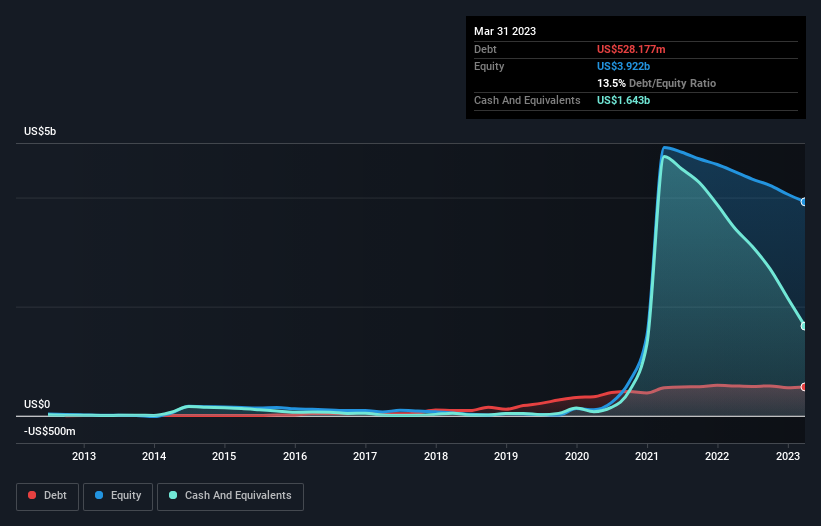
The external fund manager backed by Berkshire Hathaway's Charlie Munger, Li Lu, makes no bones about it when he says 'The biggest investment risk is not the volatility of prices, but whether you will suffer a permanent loss of capital.' So it seems the smart money knows that debt - which is usually involved in bankruptcies - is a very important factor, when you assess how risky a company is. We note that Plug Power Inc. (NASDAQ:PLUG) does have debt on its balance sheet. But should shareholders be worried about its use of debt?
What Risk Does Debt Bring?
Debt is a tool to help businesses grow, but if a business is incapable of paying off its lenders, then it exists at their mercy. If things get really bad, the lenders can take control of the business. However, a more usual (but still expensive) situation is where a company must dilute shareholders at a cheap share price simply to get debt under control. Of course, plenty of companies use debt to fund growth, without any negative consequences. The first thing to do when considering how much debt a business uses is to look at its cash and debt together.
Check out our latest analysis for Plug Power
How Much Debt Does Plug Power Carry?
The chart below, which you can click on for greater detail, shows that Plug Power had US$528.2m in debt in March 2023; about the same as the year before. But it also has US$1.64b in cash to offset that, meaning it has US$1.11b net cash.

A Look At Plug Power's Liabilities
According to the last reported balance sheet, Plug Power had liabilities of US$677.5m due within 12 months, and liabilities of US$1.05b due beyond 12 months. On the other hand, it had cash of US$1.64b and US$229.1m worth of receivables due within a year. So it can boast US$139.8m more liquid assets than total liabilities.
This short term liquidity is a sign that Plug Power could probably pay off its debt with ease, as its balance sheet is far from stretched. Succinctly put, Plug Power boasts net cash, so it's fair to say it does not have a heavy debt load! There's no doubt that we learn most about debt from the balance sheet. But ultimately the future profitability of the business will decide if Plug Power can strengthen its balance sheet over time. So if you want to see what the professionals think, you might find this free report on analyst profit forecasts to be interesting.
Over 12 months, Plug Power reported revenue of US$771m, which is a gain of 35%, although it did not report any earnings before interest and tax. With any luck the company will be able to grow its way to profitability.
So How Risky Is Plug Power?
We have no doubt that loss making companies are, in general, riskier than profitable ones. And we do note that Plug Power had an earnings before interest and tax (EBIT) loss, over the last year. Indeed, in that time it burnt through US$1.5b of cash and made a loss of US$774m. With only US$1.11b on the balance sheet, it would appear that its going to need to raise capital again soon. With very solid revenue growth in the last year, Plug Power may be on a path to profitability. By investing before those profits, shareholders take on more risk in the hope of bigger rewards. The balance sheet is clearly the area to focus on when you are analysing debt. However, not all investment risk resides within the balance sheet - far from it. We've identified 2 warning signs with Plug Power , and understanding them should be part of your investment process.
When all is said and done, sometimes its easier to focus on companies that don't even need debt. Readers can access a list of growth stocks with zero net debt 100% free, right now.
If you're looking to trade Plug Power, open an account with the lowest-cost platform trusted by professionals, Interactive Brokers.
With clients in over 200 countries and territories, and access to 160 markets, IBKR lets you trade stocks, options, futures, forex, bonds and funds from a single integrated account.
Enjoy no hidden fees, no account minimums, and FX conversion rates as low as 0.03%, far better than what most brokers offer.
Sponsored ContentNew: Manage All Your Stock Portfolios in One Place
We've created the ultimate portfolio companion for stock investors, and it's free.
• Connect an unlimited number of Portfolios and see your total in one currency
• Be alerted to new Warning Signs or Risks via email or mobile
• Track the Fair Value of your stocks
Have feedback on this article? Concerned about the content? Get in touch with us directly. Alternatively, email editorial-team (at) simplywallst.com.
This article by Simply Wall St is general in nature. We provide commentary based on historical data and analyst forecasts only using an unbiased methodology and our articles are not intended to be financial advice. It does not constitute a recommendation to buy or sell any stock, and does not take account of your objectives, or your financial situation. We aim to bring you long-term focused analysis driven by fundamental data. Note that our analysis may not factor in the latest price-sensitive company announcements or qualitative material. Simply Wall St has no position in any stocks mentioned.
About NasdaqCM:PLUG
Plug Power
Develops hydrogen fuel cells product solutions in North America, Europe, Asia, and internationally.
Flawless balance sheet and good value.
Similar Companies
Market Insights
Community Narratives



